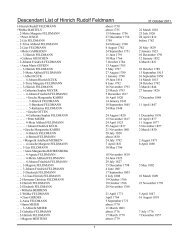Create successful ePaper yourself
Turn your PDF publications into a flip-book with our unique Google optimized e-Paper software.
Information about the<br />
<strong>Nemes</strong>, <strong>Barát</strong>, <strong>Rigó</strong>, <strong>and</strong> <strong>Szundi</strong><br />
Families<br />
Esther <strong>Nemes</strong> <strong>and</strong> her siblings were brought up in the ancient town of Inota (it had<br />
been a major Roman crossroads) which now has been incorporated into the city of<br />
Várpalota. Her ancestors, for about 100 years, had owned mills in the area, <strong>and</strong> had<br />
moved around considerably buying, operating, <strong>and</strong> selling businesses. Therefore, it is<br />
more difficult to keep track of their whereabouts in the 19th century than earlier -- when<br />
families stayed-put in one town for generations. In fact, Eszter was the first family<br />
member born in Inota.<br />
The <strong>Nemes</strong>, <strong>Barát</strong>, <strong>and</strong> <strong>Rigó</strong> families identified themselves as belonging to the<br />
Reformed faith. But, they were not particularly religious <strong>and</strong> often intermarried with<br />
Lutherans. Furthermore, many marriages seemed to be marriages of covenience, to<br />
ensure inheritance of a mill within their extended family. Family members were baptized<br />
<strong>and</strong> buried in whichever Protestant church existed in the town. [Most small towns had<br />
only one Protestant <strong>and</strong> one Roman Catholic church.] But, the marriages were usually<br />
performed in a church of the denomination of the bride -- even if it was in another town.<br />
This also makes tracking them difficult. Late in the 19th century the spelling of <strong>Rigó</strong> was<br />
changed to Riga.<br />
The 1800 map above -- of the eastern part of Veszprém megye (county) -- shows the<br />
mills along the Gaja patak (brook). That stream, like most in the area, no longer flows<br />
because the water was diverted to underground conduits to provide the huge amounts of<br />
water required for the aluminum smelter in Inota. Of the six mills the map shows in<br />
Csernye, four are documented as having been owned by family members.
Below left, is a recent photo of a <strong>Barát</strong> family mill in Csernye -- the building is<br />
unused, the mill wheel gone. This is the second mill from the right on the map. The photo<br />
below right, shows an existing windmill in Tés. Tés is the highest village in the Bakony<br />
hills, <strong>and</strong> so has no streams. Of the many windmills that were there in the early 19th<br />
century, only two remain. Neither of the two windmills in town owned by our <strong>Rigó</strong><br />
ancestors in the 1850's still exist.<br />
The <strong>Szundi</strong> Family was more educated <strong>and</strong> more religious than the other families in<br />
this line. The few <strong>Szundi</strong>s that we have found were school teachers of the Reformed<br />
faith. The alternative spelling of the name -- Szondi -- is found rather frequently. The<br />
<strong>Szundi</strong> family leads us to the Tolnai <strong>and</strong> Seres (also spelled Sörös) families of<br />
Szekszárd. There they were middle-class citizens <strong>and</strong> leaders in the Reformed church<br />
(shown below). That city has a most interesting history, though it seems impossible to tell<br />
whether our family was in Szekszárd prior to its recapture from the Turks.






